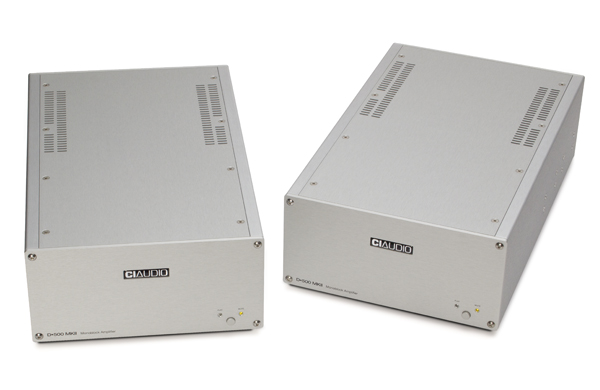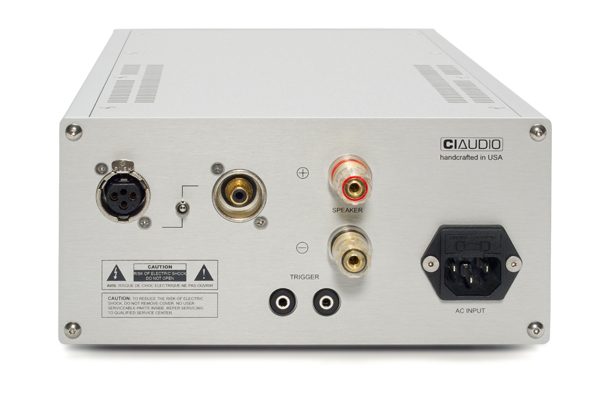Channel Islands D500 MKII Monoblocks Offer power beyond what their compact size suggests
By Jeff Dorgay Early class D amplifiers resemble the first efforts at CD players; a great idea that wasn’t fully realized on the first iteration or two. If you’ve been around long enough to remember just how bad those first CD players sounded, you’ll probably agree that the first class D amplifiers offered up the same aural aesthetic, sounding two dimensional, somewhat shrill on the top end and fatiguing after a short period of time.
Early class D amplifiers resemble the first efforts at CD players; a great idea that wasn’t fully realized on the first iteration or two. If you’ve been around long enough to remember just how bad those first CD players sounded, you’ll probably agree that the first class D amplifiers offered up the same aural aesthetic, sounding two dimensional, somewhat shrill on the top end and fatiguing after a short period of time.
In the last year or so, class D has improved dramatically and recent efforts by Devialet (a variation on the class D concept), Audio Research and Bel Canto reveal that these amplifiers can hold their own with their more current hungry brothers.
Add Channel Islands to that list, matter of fact, put them right at the top. The latest D-500 MKII monoblocks you see here are incredibly capable. Unlike other designs the CI amplifiers utilize a custom, full-bridge module that is not available to the DIY community along with some of their own circuitry. CI owner Dusty Vawter told me that they only use the UcD modulator and Class D output section of the module. The rest is customized in house. “You need to do some serious R&D to get great sound, you can’t just stick an ICE module in a box.”
Channel Islands has built some massive power supplies to go along with these amplifiers. While small on the outside, they weigh almost 30 pounds each. Popping the top reveals large capacitor banks and heavy wiring – these amps are built to rock. However a little bit of patience is required; the D500 MKIIs sound pretty stiff out of the box, but once powered up and played for about 2-3 days, the congestion clears to a bold, dynamic sound. Vawter mentioned that the modules have some power constantly applied when in standby mode, so they only take about 10 minutes to sound their best once the initial run in has been completed. Considering that these amplifiers only draw about 13 watts of power each, I suggest leaving them on all the time.
Speaker Compatibility
Past experience with Class D amplifiers reveals they are often sensitive to speaker matching, just like a vacuum tube amplifier- some combinations can be fantastic, while others can be awful, so an audition is definitely required. We made it a point to audition the D-500 MKIIs with a wide range of speakers: The Verity Rienzis, MartinLogan Aerius and ElectroMotion, the Magnepan 1.6, 1.7 and 3.7s the new Dali P5, Harbeth P3ESRs, B&Ws 805 and 802 Diamond and of course, my reference GamuT S9s.
This comprises a fairly wide range of loads, some easy to drive, others not as much. The D-500 MKIIs turned in an excellent performance in with everything on the list except for the B&W Diamonds. Wanting to verify whether this was anomalous behavior with my speakers or something else in my reference system, installing the D500 MKIIs in another system featuring 800 Diamonds exhibited the same rolloff in the HF region, compared to all the other amplifiers at my disposal. I would suggest the owners of B&W’s Diamond series to get a thorough demo first and CI agrees – they offer a 30 day money back guarantee – less a 10% restock fee and return shipping. A small price to pay to assure system synergy.
It’s also worth mentioning that the D-500 MKIIs worked well with a wider range of speakers than any other Class D amplifier I’ve yet sampled. And they are an exceptional match with the Magnepans, which are typically power hungry. If you are considering a pair of Maggies, the CI monoblocks would be at the top of my list.
 Preamplifier Compatibility
Preamplifier Compatibility
The D500 MKIIs are neutral tonally, neither adding warmth to the sound, nor forward sounding in a way that could be construed as a thin presentation. However, system synergy and compatibility is always an issue – in the view of this writer perhaps one of the most important, yet most often disregarded elements of system setup.
Marvelous results were achieved with all four of the preamplifiers on hand. (Croft 25, McIntosh C500, Burmester 011 and the Audio Research REF 5) All but the Croft were balanced preamplifiers and connected thusly. While the arguments continue to go back and forth about the value of balanced versus single ended design, I preferred the D500 MKII’s in balanced mode more – the presentation appeared a bit quieter overall. However, if you have a single ended (RCA) preamplifier, don’t shy away from these amps, you will not be disappointed.
Preferring the combination of a tube preamplifier with a solid state power amplifier to cheat the equation, if you will – getting the grip and slam of solid state with the added warmth of tubes thrown in for good measure worked well here. Neutrality is a two edged sword; some want to hear everything on a record “warts and all,” while others want hyper detail, with yet others liking a certain amount of tonal richness to the sound (that can either be described as warm, romantic or even distorted).
Biases exposed, a little bit of tonal warmth still gets my vote, as long as it doesn’t affect the pace of the music – a tough order, but it can be done. The perfect combination ended up being with the McIntosh C500 control center, a two box preamplifier that incorporates an excellent MM and MC phono stage built in, with enough inputs for everything you can imagine. Vawter encouraged me to take this direction, “We have a lot of customers that really enjoy our amps with a tube preamp.” The C500 used as a reference component at TONEAudio is hot rodded ever so slightly with a full compliment of EAT 12AX7 tubes that retains the tonal balance of this preamplifier while offering more dynamic range and a lower noise floor.
Because the D500 MK IIs possess very high gain, (32db or they can be supplied as a higher gain model featuring 38db of gain), most preamplifiers should present no problem and these amplifiers should lend themselves well to a passive preamplifier as well. When using the CI amplifiers with the ARC REF 5, the level never went past 15 on the fluorescent display to achieve maximum volume, which is very low. Even vintage preamplifiers with minimal output will have no problem driving the D500 MKIIs to maximum output.
Further Listening
The neutrality that these amplifiers exhibit makes them a great building block because they will not add to the character of other components in your system, making it easier to lock in speakers (undoubtedly the toughest component to interface with your room) and amplifier while tuning to taste, if necessary, elsewhere. Think of your amplifier and speakers as the rhythm section in a band – that essential foundation, that everything else builds upon.
Trixie Whitley’s lead vocal just leapt out of the GamuT’s on the first track, “Love Lives” from Black Dub’s self titled album, with Daniel Lanois’ backing vocals floating from left to right across the soundstage, somewhat diminished in the distance. An abrupt switch to a few trippier selections from Jean-Michel Jarre further confirmed the three-dimensionality delivered by the D500 MKIIs. Equinoxe never sounded better, and Zoolook offered up stirring bass lines.
Following this quest for bass a little further, Ursula 1000s disc, Mystics proved that the D500 MKIIs could not only deliver a large soundfield, but they could deliver deep bass with power and control. Pushing the G9’s to rave music was effortless and even at deafening volume (It felt like being back at the MICS festival in Monaco, minus the dancing girls) these amplifiers kept a lock on the pace, offering up wall shaking beats with no shrinkage of soundstage in either dimension. And of course, all the Yello tracks rattled the room.
This grand soundfield increased as I switched to vinyl – after a few of my favorite LP’s I forgot that I was listening to the tiny boxes on top of the $60,000 pair of Bumester 911 power amplifiers. Again, Vawter encouraged me to compare the D500 MKIIs to the best amplifiers I could get my hands on and they proved formidable. When listening through the GamuT S9s there was still one hurdle between the Burmester, ARC and Pass Labs amplifiers at my disposal in terms of removing the last bit of grain, or palpability, but I can’t remember ever hearing a pair of $5,000 amplifiers sounding anywhere near this good. It was only when I returned to the big bucks amps that I noticed a difference.
Making the power hungry Magnepan 1.7’s part of the equation was equally splendid. One of the biggest dilemmas with the Magnepan speakers is that while they are highly revealing for an inexpensive speaker, they require a lot of power to really light up the listening room. The D500 MKIIs took control of the Magnepans as well as some of the world’s best amplifiers have- I can’t think of an amplifier I would suggest more highly for someone looking to build a high performance system around the 1.7’s (or the 3.7’s for that matter) at a reasonable cost.
The absence of a sound
The Channel Islands D500 MKII amplifiers sounded great and made no missteps while in our care. We will be adding them to our reference fleet of amplifiers, so you will be hearing more about them in the months to come. I feel compelled to give these amplifiers one of our Exceptional Value Awards for 2011 as well – they represent tremendous performance and build quality. A well thought out product in every way.
The Channel Islands D500 MKII monoblocks
$5,000/pair
www.ciaudio.com
Peripherals
Preamplifier McIntosh C500
Analog Source AVID Acutus Reference SP w/SME V and Koetsu Usushi Blue
Phono Stage ARC REF Phono 2
Speakers Gamut S9
Power Running Springs Maxim and Dmitri power line conditioners


